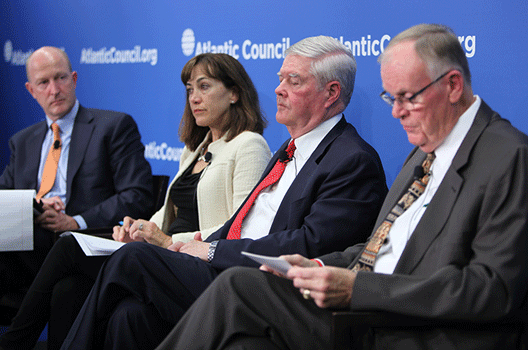The national security challenge posed in the Arctic by the growing presence of Russia and China as well as climate change makes it imperative for the United States to develop the strategic infrastructure needed to play a key leadership role, while maintaining safety and security in the region, said a senior White House official.
According to Amy Pope, deputy homeland security adviser and deputy assistant to US President Barack Obama at the National Security Council, “it was clear that with a rapidly changing climate we needed to put in a leadership structure to guide US activity in the region.” The United States must prepare to engage other countries in a coordinated way in the region, she said at the Atlantic Council on October 25.
The United States currently holds the chairmanship of the Arctic Council. In the spring of 2017, Finland will assume the role.
Though a number of geopolitical concerns stress US relations with a key member of the Arctic Council—Russia, Pope, who also serves as the vice chair for the White House Arctic Executive Steering Committee, said that “the Arctic is peaceful, stable, and free from conflict, and we intend to keep it that way.”
Retired Rear Adm. Donald P. Loren, a former deputy assistant secretary of defense, said the United States must be economically strong, militarily powerful, and diplomatically important in an increasingly significant region of the world. “We have to stake our claim to the region and exercise our leadership,” he said.
Pope and Loren participated in a conference at the Atlantic Council on Geopolitics, Security, and Energy in the Arctic. The conference gathered a variety of experts to discuss the importance of assessing the geopolitical currents defining the Arctic, how they define US interests, and the actions the US government should take to protect those interests.
From a strategic standpoint, the United States can achieve “greater security by allowing the responsible development of our Arctic energy sources,” said Loren. “National security strategy is not merely a military strategy, it is a military, economic, diplomatic…and energy strategy.”
“National security experts recognize the geostrategic importance of the Arctic and our Arctic energy resources to our national security strategy as a whole,” he added.
Energy independence would not only help the United States avoid relying on Russian oil, but also allow for the use of energy exports as tools for diplomacy “to help allies who are energy blackmailed by adversaries,” said Loren. The European Union currently relies on Russia for over one-third of its gas imports.
Pope asserted that the construction of another icebreaker would play a significant role in furthering US interests in the region, especially as melting ice means shipping routes are beginning to run through Arctic waters. The United States must be able to maintain year-round access to the Arctic in order to compete, she said. While the United States currently has two icebreakers, Russia has forty.
There has been a tremendous amount of technological and scientific advancements due to the work the United States has conducted in the Arctic, said Mead Treadwell, president of Pt Capital and a former lieutenant governor of Alaska. On September 28, the White House hosted twenty-five nations committed to cooperative scientific research in the Arctic for the first White House Arctic Science Ministerial.
Treadwell, who is also the former chair of the US Arctic Research Commission, said that the United States spends $400 million annually on Arctic research, adding that “oil and gas development has been one of the major reasons to pay for that science as we went along.”
However, according to Loren, “there is no country on the planet…that would attempt and achieve the ability to develop, extract petroleum in a more environmentally responsible manner than the United States.”
“There has to be a national strategy, which we do not have, to decarbonize,” said retired Rear Adm. David Titley, director for the Center for Solutions to Weather and Climate Risk at Pennsylvania State University. As indicated by the rapidly melting sea ice, “the Arctic is a place where climate change is not some distant far-off theory…it’s happened.” He discussed the need to plan for climate intervention and the management of increased human activity in the region.
In this regard, the panelists agreed that US leadership will be crucial. “We limit our options to participate and react if we don’t even have the presence and the infrastructure to operate in the area,” said Loren.
Titley said that the future of the climate situation is more predictable than the future of the security situation in the Arctic. “There are big changes, year to year, but we know the trend,” he said. “That trend is going to be opening up the Arctic—increased human activity.” According to Janine Davidson, undersecretary for the US Navy, “conflict happens where the people are.”
Davidson described how US armed forces, namely the Coast Guard and the Navy, “will need to adapt in order to operate in this changing environment.”
Above all, the military promotes safety and defense cooperation, Davidson said, but it is prepared to respond to perceived threat. While the Arctic can’t be looked at exclusively through a military lens, she said, that point of consideration is essential.
Retired Gen. Joseph Ralston, who has previously served as supreme allied commander for Europe in NATO, commander of the US European Command, and commander of the Alaska Command in the North American Aerospace Defense (NORAD) region, described the strategic military advantage of Alaska’s location, noting in particular its proximity to Russia. Though “we all want a peaceful and stable Arctic,” Ralston said, this advantage must be considered for both air and army forces as part of a comprehensive security strategy.
“FedEx and UPS understand the strategic importance of Alaska more than the Pentagon does,” he said. Both companies have headquarters in the state.
With regard to Russian activity in the Arctic, Ralston commended the Kremlin’s “strategic vision,” but added, “some of the things they are doing are not stable.”
When assessing the potential threat posed by Russian infrastructure in the Arctic, Ralston described the need to consider both capability and intent in order to appropriately respond. While capability is easily measured, Ralston said: “I’m not about to try to predict what [Russia’s] intent is, but the intent can change overnight. You have to have the matching capability.”
Retired Adm. James M. Loy, a former deputy secretary at the Department of Homeland Security and former commandant of the US Coast Guard, emphasized the importance of the Law of the Sea Convention with regard to US activity in the Arctic. The treaty, ratified by 167 nations, including Russia and China, defines the rights and responsibilities of nations in terms of their movements throughout the world’s oceans. Territorial disputes are also settled in this forum.
The United States has not ratified the agreement, and therefore does not have a seat at the table when these issues are discussed. This decision not to participate hinders national security developments, according to Loy. “We hamstring ourselves with our own decisions, and a step back will put us in even more jeopardy,” he said.
These considerations do not necessarily indicate a militarization of the Arctic, said Davidson, but security forces are involved. Ian Brzezinski, a senior fellow at the Atlantic Council’s Brent Scowcroft Center on International Security, said: “It’s a matter of balance and prudence, but we also have to be deliberate.”
Rachel Ansley is an editorial assistant at the Atlantic Council.
Image: From left: Ian Brzezinski, a senior fellow at the Atlantic Council’s Brent Scowcroft Center on International Security, moderated a discussion with Janine Davidson, undersecretary for the US Navy; Retired Gen. Joseph Ralston, who has previously served as supreme allied commander for Europe in NATO, commander of the US European Command, and commander of the Alaska Command in the North American Aerospace Defense (NORAD) region; and Retired Adm. James M. Loy, a former deputy secretary at the Department of Homeland Security and former commandant of the US Coast Guard. (Atlantic Council/Victoria Langton)

